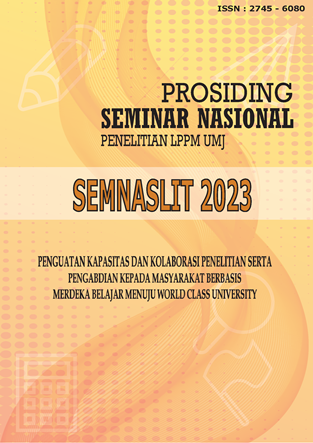POTENSI PAKAN MENGANDUNG OMEGA-3 MENGGUNAKAN MIKROALGA AURANTIOCHYTRIUM UNTUK INDUSTRI PERIKANAN YANG BERKELANJUTAN
Abstract
Sebagai produsen alami asam lemak omega-3 yang esensial, mikroalga Aurantiochytrium dapat diintegrasikan ke dalam pakan ikan, meningkatkan kualitas daging ikan, dan meningkatkan ketahanan terhadap stres lingkungan. Kemampuannya sebagai pengganti minyak ikan konvensional mendukung praktik budidaya yang berkelanjutan dan mengurangi tekanan pada sumber daya laut. Tulisan ini menampilkan eksperiman isolasi mikroalga Auranticohytrium dan produksi biomassanya skala laboratorium. Kultivasi dilakukan dengan nutrisi glukosan dan ekstrak kamir (yeast extract) dengan perbandingan 3:1. Tingkat pH biomassa yang dihasilan 6,7 dan biomassa basah pada penelitian ini 11,22 gram/liter. Selanjutnya, potensi biomassa mikroalga Aurantiochytrium dibahas. Dengan potensi yang ada, inovasi pakan dari biomassa mikroalga Aurantiochyrium tidak hanya mendukung pertumbuhan industri perikanan secara berkelanjutan tetapi juga menciptakan peluang inovasi dalam pengembangan produk pangan fungsional yang bermanfaat bagi kesehatan manusia. Dengan menggabungkan potensi nutrisi dan keberlanjutan, mikroalga Aurantiochytrium muncul sebagai solusi yang menjanjikan untuk meningkatkan efisiensi dan dampak positif dalam industri perikanan global.References
Carter, C. G., Bransden, M. P., Lewis, T.., & Nichols, P. D. (2003). Potential of hraustochytrids to Partially Replace Fish Oil n Atlantic Salmon Feeds. 480–492. https://doi.org/10.1007/s10126-002-0096-8
Evonik. (2018). DSM and Evonik stablish Veramaris joint venture. https://corporate.evonik.com/en/media/pressreleases/nutrition-and are/pages/article.aspx?articleId=100424
Evonik. (2019). Evonik and DSM joint venture Veramaris named world’s best-selling algae-based omega-3 supplier to aquacultureTitle. https://corporate.evonik.com/en/pages/article. aspx?articleId=118968%0D
FAO. (2018). The State of World Fisheries and Aquaculture. In FAO (Vol. 61, Issue 1).https://doi.org/10.6024/jmbai.2019.61.1.2053- 01
Gao, M., Song, X., Feng, Y., Li, W., & Cui, Q. (2013a). Isolation and characterization of Aurantiochytrium species: High docosahexaenoic acid (DHA) production by the newly isolated microalga, Aurantiochytrium sp. SD116. Journal of Oleo Science, 62(3), 143–151. https://doi.org/10.5650/jos.62.143
Gao, M., Song, X., Feng, Y., Li, W., & Cui, Q. (2013b). Isolation and characterization of Aurantiochytrium species: high docosahexaenoic acid (DHA) production by the newly isolated microalga, Aurantiochytrium sp. SD116. Journal of Oleo Science, 62(3), 143–151. https://doi.org/10.5650/jos.62.143
Grealis, E., Hynes, S., Donoghue, C. O., Vega, A., & Osch, S. Van. (2017). The economic impact of aquaculture expansion : An input- output approach. Marine Policy, 81(March), 29–36. https://doi.org/10.1016/j.marpol.2017.03.014 Harel, M., Koven, W., Lein, I., Bar, Y.,
Behrens, P., Stubblefield, J., Zohar, Y., & Place, A. R. (2002). Advanced DHA , EPA and ArA enrichment materials for marine aquaculture using single cell heterotrophs. 213, 347–362.
Hixson, S. M., & Arts, M. T. (2016). Climate warming is predicted to reduce omega- 3, long-chain, polyunsaturated fatty acid production in phytoplankton. Global Change Biology, 22(8), 2744–2755. https://doi.org/10.1111/gcb.13295
Honda, D.; Yokochi, T.; Nakahara, T.; Erata, M.; Higashihara, T. (1998). Schizochytrium limacinum sp. nov., a new thraustochytrid from a mangrove area in the west Pacific Ocean. Mycol. Res. 1998, 102, 439–448., 102, 439–448.
Honda, D., Yokochi, T., Nakahara, T., Erata, M., & Higashihara, T. (1998). Schizochytrium limacinum sp. nov., a new thraustochytrid from a mangrove area in the west Pacific Ocean. Mycological Research, 02(4), 439–448. https://doi.org/10.1017/S0953756297005170
Hong, D. D., Anh, H. T. L., & Thu, N. T.. (2011). Study on biological characteristics of eterotrophic marine microalga- chizochytrium mangrovei pq6 isolated from hu quoc island, kien giang province, vietnam. Journal of Phycology, 47(4), 944–954. ttps://doi.org/10.1111/j.1529- 817.2011.01012.x
Hutari, A., An Nisaa, R., Suhendra, S., gustin, Y., & Ayunda, K. A. (2022). xploration Of High Economic Value icroalgaes In The Mangrove Area Of Pari sland, Seribu Islands, Jakarta. JURNAL EMBELAJARAN DAN BIOLOGI NUKLEUS, (3), 662–672. https://doi.org/10.36987/jpbn.v8i3.3096
Ji, X., Ren, L., & Huang, H. (2015). mega-3 biotechnology : a green and ustainable process for omega-3. 3(October), 389–3390. https://doi.org/10.3390/nu5041301
Jung, I. S., & Lovitt, R. W. (2010). quacultural Engineering Integrated roduction of long chain polyunsaturated fatty cids (PUFA) -rich Schizochytrium biomass sing a nutrient supplemented marine quaculture wastewater. Aquacultural ngineering, 43(2), 51–61. https://doi.org/10.1016/j.aquaeng.2010.05.00
Lenihan-geels, G., Bishop, K. S., & erguson, L. R. (2013). Alternative Sources of mega-3 Fats: Can We Find a Sustainable ubstitute for Fish? 1301–1315. ttps://doi.org/10.3390/nu5041301
Marketsandmarkets. (2023). Quaculture Products Market. https://www.marketsandmarkets.com/Market- eports/aquaculture-product-market- 224024.html?gclid=CjwKCAjwxOymBhAFEiwnodBLPTkUfUk1vlNm8_GfPnA5dF1tKvTOm u7VtX5BRRY1uPsPpM6GbIlhoC9B4QAvD_B E
Muller-Feuga, A., Robert, R., Cahu, C., obin, J., & Divanach, P. (2007). Uses of icroalgae in Aquaculture. Live Feeds in arine Aquaculture, Rosenberry 1998, 253–99. https://doi.org/10.1002/9780470995143.ch7 Nobrega, R. O., Batista, R. O., Corrêa, C.
Mattioni, B., Filer, K., Pettigrew, J. E., & Fracalossi, D. M. (2019). Dietary supplementation of Aurantiochytrium sp. meal, a docosahexaenoic-acid source, promotes growth of Nile tilapia at a suboptimal low temperature. Aquaculture, 507(May), 500–509. https://doi.org/10.1016/j.aquaculture.2019.04. 030
Shah, B. R., & Mraz, J. (2020). Advances in nanotechnology for sustainable aquaculture and fisheries. Reviews in Aquaculture, 12(2), 925–942. https://doi.org/10.1111/raq.12356
Singh, A., Wilson, S., & Ward, O. P. (n.d.). Docosahexaenoic Thraustochytrium acid ( DHA ) production. 1.
Suhendra, S., Sulistiawati, E., Evitasari, T., Ariandi, T. R., Septianingsih, L., & Hutari, (2023). Bioprocess potentials of urantiochytrium microalgae from Kulonprogo angrove forest Yogyakarta, Indonesia. AIP onference Proceedings, 2667. https://doi.org/10.1063/5.0112298
Taberna, E. G. (2008). Heterotrophic ultivation of microalgae as a source of ocosahexaenoic acid for aquaculture.
Taoka, Y. (2017). Aquaculture and isheries 2017. J Fisheries Livest Prod 2017, 5:2 Suppl), 5(2), 4172.

